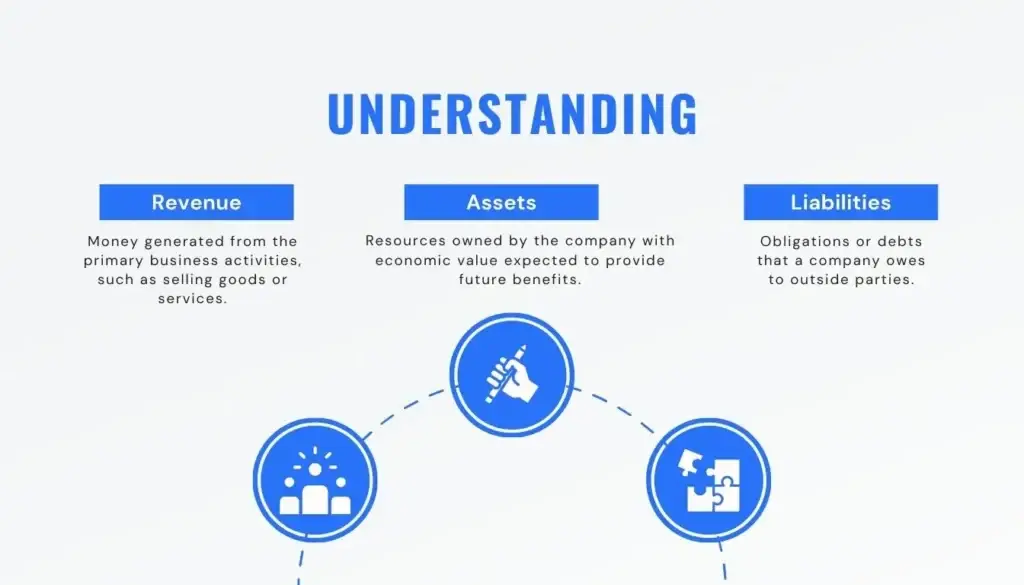In the world of accounting, terms like revenue, assets, and liabilities are fundamental, yet they often cause confusion. Each of these elements plays a crucial role in a company’s financial health and reporting. This blog post will explain these terms in detail, provide examples, and present their differences in a simple and clear manner.

What is Revenue?
Revenue refers to the total amount of money generated by the sale of goods or services related to a company’s primary operations. It is often called the “top line” because it appears at the top of the income statement and indicates the core activities that bring in income.
Example: If a company sells $100,000 worth of products in a month, that $100,000 is its revenue for that month.
Journal Entry for Revenue:
- Date: When the sale is made.
- Debit: Accounts Receivable or Cash (if the sale was made on credit or for cash)
- Credit: Sales Revenue
Journal Entry Example:
Account Debit Credit
-----------------------------------------------------------
Accounts Receivable $100,000
Sales Revenue $100,000What is an Asset?
Assets are resources owned by a company that have economic value and are expected to provide future benefits. Assets can be tangible, like machinery and buildings, or intangible, like patents and trademarks. They are recorded on the balance sheet and classified into current assets and non-current (or fixed) assets.
- Current Assets: Expected to be converted into cash or used up within one year (e.g., cash, accounts receivable, inventory).
- Non-Current Assets: Provide economic benefits beyond one year (e.g., property, plant, and equipment, long-term investments).
Example: A company owns a delivery truck valued at $50,000. This truck is considered an asset.
Journal Entry for Asset:
- Date: When the asset is acquired.
- Debit: Asset Account (e.g., Vehicles, Equipment)
- Credit: Cash or Accounts Payable (if purchased on credit)
Journal Entry Example:
Account Debit Credit
-----------------------------------------------------------
Vehicles $50,000
Cash $50,000What is a Liability?
Liabilities are obligations or debts that a company owes to outside parties. They represent claims against the company’s assets and are settled over time through the transfer of money, goods, or services. Liabilities are recorded on the balance sheet and can be classified into current liabilities and long-term liabilities.
- Current Liabilities: Due to be settled within one year (e.g., accounts payable, short-term loans, wages payable).
- Long-Term Liabilities: Due after one year (e.g., long-term loans, bonds payable).
Example: If a company takes out a $200,000 loan to purchase equipment, this amount is recorded as a liability on the balance sheet.
Journal Entry for Liability:
- Date: When the liability is incurred.
- Debit: Cash or Asset Account (if the loan is used to purchase an asset)
- Credit: Liability Account (e.g., Loans Payable)
Journal Entry Example:
Date Account Debit Credit
-----------------------------------------------------------
Cash $200,000
Loans Payable $200,000Differences Between Revenue, Assets, and Liabilities
To clearly understand how these elements differ, let’s summarize them in a table:
| Feature | Revenue | Asset | Liability |
|---|---|---|---|
| Definition | Money generated from primary business activities | Resources owned by the company with economic value | Debts or obligations owed to outside parties |
| Financial Statement | Income Statement | Balance Sheet | Balance Sheet |
| Nature | Income | Economic resources | Obligations or debts |
| Impact | Increases equity (net income) | Increases the total assets | Increases the total liabilities |
| Examples | Sales revenue, service income | Cash, inventory, property, equipment | Loans payable, accounts payable, mortgages |
| Journal Entry (Debit) | Accounts Receivable, Cash | Asset Account (e.g., Vehicles, Equipment) | Cash or Asset Account |
| Journal Entry (Credit) | Sales Revenue | Cash or Accounts Payable | Liability Account (e.g., Loans Payable) |
Summary
Understanding the differences between revenue, assets, and liabilities is essential for accurate financial reporting and analysis.
- Revenue represents the money earned from the company’s core business operations and is recorded on the income statement.
- Assets are resources owned by the company with future economic benefits and are listed on the balance sheet.
- Liabilities are the company’s financial obligations to outside parties, also recorded on the balance sheet.
By accurately categorizing and recording these financial elements, businesses can maintain clear and precise financial records, which are crucial for decision-making, strategic planning, and ensuring financial health.



